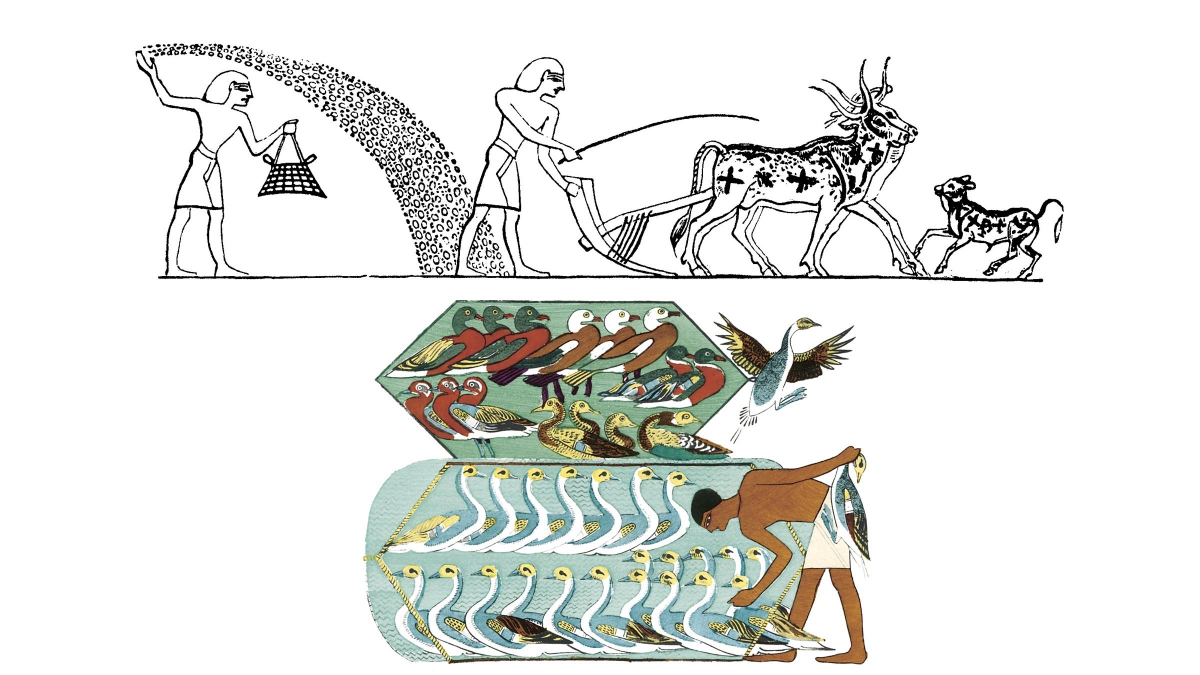Plants and Animals of the Nile
The ancient inhabitants of the Nile were closely aware of their physical surroundings, especially the other living things in the valley. Egyptian art is filled with wonderful pictures of the animals and plants that the Ancient people knew and loved. Because of the nature of the country, there were two different kinds of animals and plants: those of the desert and those of the river and fertile land. Animals of the desert included jackals, vultures, antelope and lions. By the river, the wild life included birds of all varieties, fish, and domesticated animals such as cattle, sheep and goats.
 Many of these animals were important not only because of the role they played in the daily lives of the people, but because of their religious significance. The Ancient Egyptians saw and admired the power and beauty of the animals they lived with. They used images of those animals as metaphors for the power and beauty of their gods. Hawks or falcons, who soar high in the sky, and, sharp-eyed, swoop suddenly to catch their prey, were used to depict the sun-god. The gentle cow, with her lovely big brown eyes, could be used as an image of Hathor, goddess of love and beauty. Baboons, who look and sometimes act like humans, and ibises who spend much of their time searching, were associated with the god of wisdom.
Many of these animals were important not only because of the role they played in the daily lives of the people, but because of their religious significance. The Ancient Egyptians saw and admired the power and beauty of the animals they lived with. They used images of those animals as metaphors for the power and beauty of their gods. Hawks or falcons, who soar high in the sky, and, sharp-eyed, swoop suddenly to catch their prey, were used to depict the sun-god. The gentle cow, with her lovely big brown eyes, could be used as an image of Hathor, goddess of love and beauty. Baboons, who look and sometimes act like humans, and ibises who spend much of their time searching, were associated with the god of wisdom.
Some animals which appear in ancient Egyptian representations, such as lions and wild bulls, are no longer found in the Nile Valley; these two animals were hunted out nearly 2,000 years ago. Other animals which appear on objects from around 3,000 BCE are no longer seen because of changes in climate over thousands of years. The size of the Sahara desert has also waxed and waned with changes in climate.
The annual flood enabled farmers to plant and cultivate vegetables and many grains, such as spelt, millet, barley and emmer wheat, and high protein lentils and chick-peas. Pomegranates, figs, dates, grapes and other fruits also grew well. This gave the average Egyptian of the Old Kingdom a fairly wide selection of foods. The basis of everyman's simple diet was bread, made with emmer wheat or barley, along with vegetables, fruits, and beer. Red meat, such as goat, mutton and perhaps pork, and poultry were not regular items of a poor person's diet, although fish and water birds may have been more readily available. Beef was a luxury reserved. Tomatoes and potatoes, both widely eaten in modern Egypt, would not become available until contact with North and South America.
Everybody, rich and poor, young and old, drank beer. Unlike modern beers, it was made without hops, and tended to be a bit thick. It was made at home by taking barley or wheat mash, adding more liquid, and sometimes sweetener or spice, and letting it ferment. Wine made from grapes was a luxury item, made in the Delta and the Oases. Other wines were made from the fermented juices of pomegranates and dates.
Flax was an important crop which could be processed into linen for clothing and other necessities. One of the most useful crops was papyrus. Although today the only papyrus left in Egypt is cultivated, in prehistoric and pharaonic times the wetter parts of the Nile Valley and large areas of the Delta were papyrus swamp, in which the plants grew to heights of up to 3 metres. Scribes wrote records and books on papyrus, but this was not the only use. The stalks were twined and bundled to make boats; the inner bark was woven into sailcloth, matting, blankets and ropes; and the lower stock and roots were eaten by both people and cattle.
